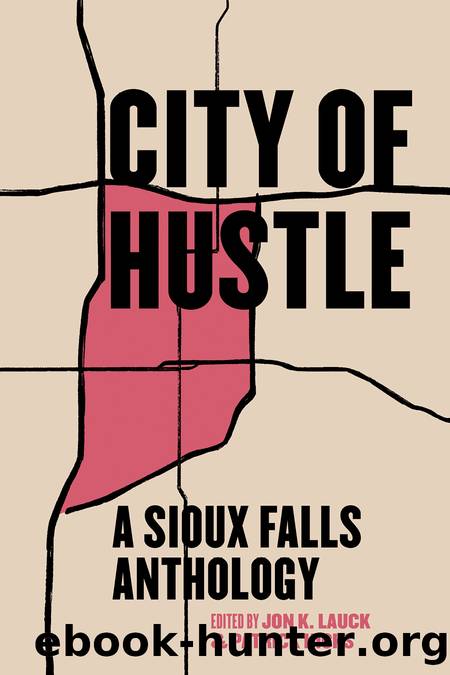City of Hustle by Patrick Hicks

Author:Patrick Hicks
Language: eng
Format: epub
Publisher: Belt Publishing
Published: 2022-06-02T15:11:56+00:00
Falls Park
Marty McGoey
I love Dakota more and moreâ
Her prairies vast, her mines of oreâ
I love her mountains and her glades,
But most her beautiful cascades.
âpoem published in American Miller, 1880
All water has a voice. Whether it is moving or still, water calls to us. Many communities are built because of water at the confluence of rivers, on gulfs or bays, or where rivers meet larger bodies, be they oceans or lakes. The functional purpose for building on water is for the faster and easier transportation of goods, but I think water also beckons to us. We are drawn toward it, maybe out of respect for the past and the ancestors who crossed over it, maybe because we are biologically mostly water, or maybe because we are thirsty and water brings life? Perhaps itâs due to religious connections with baptism, Noahâs ark, and Mosesâs infant journey down the Nile? It could also be the smell of fresh or saltwater or the play of light on the surface that we can stare at for hours, fishing or just meditating.
Located in the north central part of Sioux Falls, the falls of the Big Sioux, and the cityâs namesake, offer so many sensory delights of light variations, smells, and sounds. On a pleasant day, people congregate at Falls Park as though it were a kind of church or gathering place. Visiting the park is an obligation for travelers and longtime residents, as it is a place of natural and human history. Calm days with perfect weather can be rare, but when they happen on weekends, you can bet that the park will be filled with people staring at the water, fishing in the Big Sioux, walking dogs, picnicking, and browsing the posted signs that reveal the history of the falls and the city.
The falls were formed thousands of years ago by a melting glacier that poured over bedrock quartzite. Archeological evidence suggests that prior to European exploration, the area around the falls was used as a camp by nomadic hunters who constructed burial mounds nearby. Later came the Oneota, ancestors of the Mandan, a more permanent and agricultural society than the nomads. The Lakota arrived in the area in the eighteenth century to find the mounds and camps as ancient ruins.
Stories of the falls were one of the major draws to the area, long before the rocks in the area were quarried or when the sidewalks of the park were paved. The history of the falls is inextricably tied to the city named for them. A description of the falls by French scientist and explorer Joseph Nicolletâwho called them âbeautiful and picturesqueââwas one of the first draws for town settlers and developers. Local Native tribes called the river âTe-han-Kas-an-data,â which translates to âthickly wooded river.â Itâs hard to imagine thick woods on the Big Sioux, even though photographic records prove otherwise. Many other historic photos of the area only miles away from the falls show rolling plains broken only by sparse trees and new buildings built by early residents.
Download
This site does not store any files on its server. We only index and link to content provided by other sites. Please contact the content providers to delete copyright contents if any and email us, we'll remove relevant links or contents immediately.
Giovanni's Room by James Baldwin(6814)
The Plant Paradox by Dr. Steven R. Gundry M.D(2430)
The Stranger in the Woods by Michael Finkel(2330)
Miami by Joan Didion(2166)
Wild: From Lost to Found on the Pacific Crest Trail by Cheryl Strayed(2133)
INTO THE WILD by Jon Krakauer(2086)
Trail Magic by Trevelyan Quest Edwards & Hazel Edwards(2063)
DK Eyewitness Top 10 Travel Guides Orlando by DK(2058)
Vacationland by John Hodgman(2033)
The Twilight Saga Collection by Stephenie Meyer(2029)
Nomadland by Jessica Bruder(1960)
Birds of the Pacific Northwest by Shewey John; Blount Tim;(1876)
The Last Flight by Julie Clark(1832)
Portland: Including the Coast, Mounts Hood and St. Helens, and the Santiam River by Paul Gerald(1820)
On Trails by Robert Moor(1794)
Deep South by Paul Theroux(1718)
Blue Highways by William Least Heat-Moon(1664)
Trees and Shrubs of the Pacific Northwest by Mark Turner(1645)
1,000 Places to See in the United States and Canada Before You Die (1,000 Places to See in the United States & Canada Before You) by Patricia Schultz(1558)
